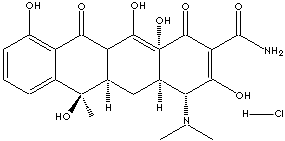| CAS
NO. |
64-75-5 |

|
| EINECS
NO. |
200-593-8 |
| FORMULA |
C22H24N2O8·HCl |
| MOL
WT. |
480.90 |
|
H.S.
CODE
|
|
|
TOXICITY
|
|
| SYNONYMS |
|
| 4S-(4alpha,4aalpha,5aalpha,6beta,12aalpha))-4-(Dimethylamino)-
1,4,4a,5,5a,6, 11,12a- octahydro-3,6,10,12,12a-pentahydroxy-6-methyl-
1,11-dioxo-2-naphthacenecarboxamide,
monohydrochloride; Achromycin Hydrochloride; Panmycin Hydrochloride;
|
|
CLASSIFICATION
|
|
|
PHYSICAL
AND CHEMICAL PROPERTIES
|
| PHYSICAL
STATE |
off-white
powder |
| MELTING
POINT |
220
- 223 C (Decomposes) |
| BOILING
POINT |
|
| SPECIFIC
GRAVITY |
|
| SOLUBILITY
IN WATER |
Soluble
(5-10 g/100ml at 24 C) |
| pH |
2.0
-2.5 (2% sol.) |
| VAPOR
DENSITY |
|
|
AUTOIGNITION
|
|
|
NFPA
RATINGS
|
Health: 2; Flammability: 0; Instability: 1 |
|
REFRACTIVE
INDEX
|
|
| FLASH
POINT |
|
| STABILITY |
Stable
under ordinary conditions. Light, moisture sensitive. |
|
GENERAL
DESCRIPTION AND APPLICATIONS
|
|
Tetracycline is a member of the tetracycline family useful because of broad
antimicrobial action. It is chiefly used in treating infections caused by
streptococci, staphylococci, Gram-negative bacilli, rickettsiae, and certain
protozoans and viruses. Tetracycline can be produced biosynthetically by
fermentation with a strain of Streptomyces aureofaciens (or certain other
species) or chemically by hydrogenolysis of chlortetracycline. Tetracyclines
inhibit bacterial protein synthesis by binding to the 30S ribosomal subunit.
Tetracycline act as a inhibitor of a growth (bacteriostatic) rather than
killer of the infectious agent (bacteriocidal) and is only effective against
multiplying microorganisms.
Tetracycline antibiotics include;
- Chlortetracycline (CAS # : 57-62-5)
- Demeclocycline Hydrochloride (CAS # : 64-73-3)
- Demethylchlortetracycline (CAS # : 127-33-3)
- Dihydrostreptomycin Sesquisulfate (CAS # : 5490-27-7)
- Doxycycline (CAS # : 564-25-0)
- Duramycin (CAS # : 1391-36-2)
- Meclocycline Sulfosalicylate (CAS # : 73816-42-9)
- Methacycline
Hydrochloride (CAS # : 3963-95-9)
- Minocycline (CAS # : 10118-90-8)
- Neomycin (CAS # : 1404-04-2)
- Oxytetracycline (CAS # : 6153-64-6)
- Streptomycin (CAS # : 57-92-1)
- Tetracycline (CAS # : 60-54-8)
- Vancomycin (CAS # : 123409-00-7)
|
| SALES
SPECIFICATION (USP/BP) |
|
APPEARANCE
|
off-white
powder |
|
ASSAY
|
95.0%
min
|
| TRANSPORTATION |
| PACKING |
|
| HAZARD
CLASS |
|
| UN
NO. |
|
| SAFETY INFORMATION |
|
HAZARD OVERVIEW |
GHS (Globally Harmonised System) Classification: Acute toxicity (Oral). Hazard statements: Harmful if swallowed. Potential Health Effects: Eyes - May cause eye irritation. Skin - Harmful if absorbed through skin. May cause skin irritation. Ingestion - Harmful if swallowed. Inhalation - May be harmful if inhaled. May cause respiratory tract irritation. |
|
GHS |
|
|
SIGNAL WORD |
Warning |
|
PICTOGRAMS |

|
|
HAZARD STATEMENTS |
H302 |
|
P STATEMENTS |
P264-P270-P301 + P312-P330-P501 |
|
EC DIRECTIVES |
|
|
HAZARD CODES |

|
|
RISK PHRASES |
22 |
|
SAFETY PHRASES |
22-36 |
| PRICE INFORMATION |
|
|


![]()